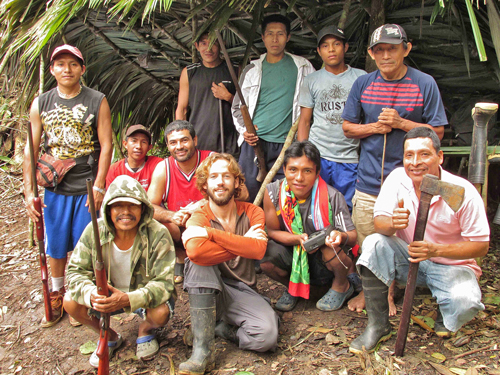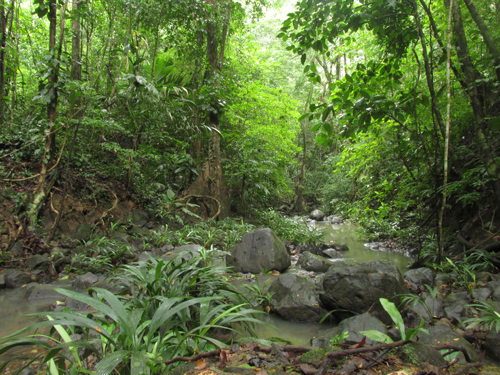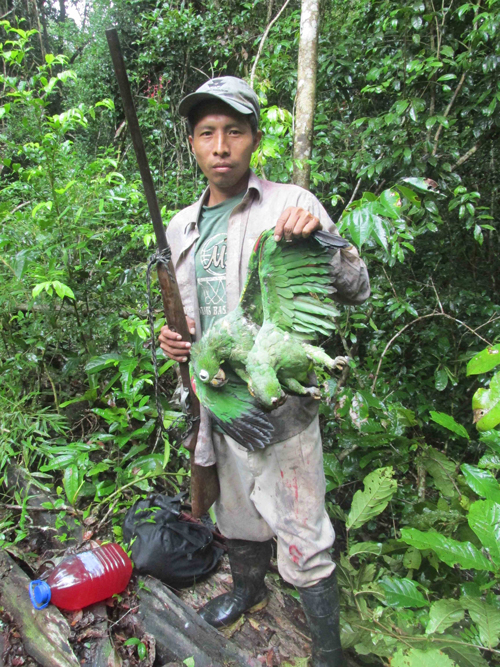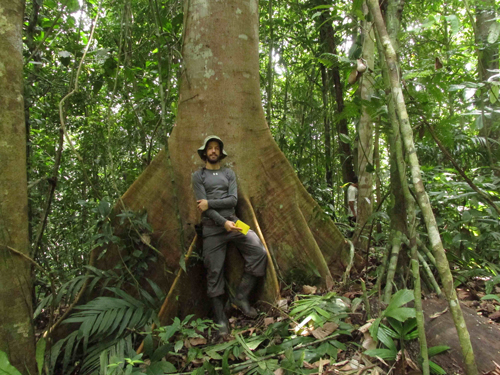
By Ira Sutherland
We have arrived at a remote, unspoiled tropical forest in eastern Panama and it will be home for the next 12 days.
A hacking sound erupts as the team, one Latin Panamanian and nine local indigenous people, begin to clear camp with machetes. I stay back at the dugout canoe to mark our position with GPS and while doing so, take note of my surroundings. Flowing from a steep canyon, a small stream trickles below me while mysterious clicks and hisses emanate from unseen insects. A black ant, thicker than a pencil, speeds up an immense tree towards a profusion of leafy green canopy leaves 30 meters above. The understory features spiny palms and meter-long aroid leaves entangled in a jungle perceptibly difficult to manoeuvre through.
The fact that I will be the first researcher, the first westerner, in fact, to penetrate the depths of this forest gives the setting a genuinely pristine feel.

We are permitted access by Panama’s Kuna indigenous people because our objective is to train the Kuna in methods to measure and evaluate the carbon stored in their forests. Panama is a testing ground for an ambitious United Nations program called Reducing Emissions from Deforestation and Degradation (REDD+), which aims to collect money from developed nations like Canada to pay landholders in developing nations not to cut down their forests. The program holds tremendous potential to reduce global deforestation and associated CO2 emissions, which account for about 20 per cent of anthropogenic CO2 emissions. However, REDD+ is difficult to implement, and often criticized, in part, because its alleged that local people will likely not receive fair compensation while sacrificing autonomy over their forest.
To counter this dilemma Dr. Catherine Potvin of McGill has decided to frame part of her research in Panama around empowering the Kuna to fully understand, and also be able to measure, the value of carbon locked up in the trees of their forest [To read more about Potvin’s work, click here].

During our first night a tropical rainstorm hit with such force and persistence that the gentle stream we had boated up on swelled to a torrent of churning brown water. On our second night I witnessed a small snake, said to be venomous, be killed in camp and I was told that the large black ants, bullet ants as they call them, can deliver extraordinarily painful stings.
Fortunately, the Kuna are experts in this environment so that managing hazards such as adverse weather, venomous snakes, scorpions, ground wasps and killer bees is simply second nature. In fact, in their company and with their instruction it was evident that many of these rather frightful forest elements were little more hazardous than creatures I am more familiar in the woods of Canada.
Our task is to locate study sites placed across the landscape. None of these sites are far away, but each presents its own challenges.
Some sites are in difficult to access mountainous terrain patterned with a complex arrangement of sharp ridges and steep ravines. Flat sections are possibly worse, because there we encountered impenetrable, three-meter-high thickets of a spiny bromeliad they call piña del monte or ‘pineapple of the mountain.’ That plant could halt an infantry battalion in its tracks, but the local men patiently chop through with machete.
With calm and patience, tree by tree, site by site, we work through until our work itinerary is complete.
We return exhausted, though, enlivened by the experience. The results from our work will not only serve the Kuna, but are also of interest to general science.
Our data analysis shows this forest contains a richness of carbon unrivalled by any forest previously examined in Panama. This is significant because the tropical forests of Panama are among the most intensively studied tropical forests on Earth. One exceptional grove, I recall, had the atmosphere of a lost ancient cathedral; tree stems approached 2 meters thick and were 40-50m tall. It was pouring rain and steamy mist hung in clouds throughout the canopy obscuring view. I had a strange feeling like I was immersed in a soup of sacred life.

The expedition was tough for me, and for all of us. We worked 11 hours a day for 10 days straight with extremely simple foods, served in rationed proportions. By the end several crew members had light injuries, we all had lost considerable weight.
Such a job is unsuitable for most folks but my personal lifestyle is built around adventure and exploration. I tolerate discomfort and cherish great challenge. I did this work as a volunteer, partly for the experience, partly because the opportunity was too great to pass up. But I think the greatest motivation was that intrinsic human drive for scientific discovery. The experience felt timeless, like we were somehow seizing a lost opportunity to reconnect with an ancient tradition of Earth exploration.
Ira Sutherland, is no stranger to forest exploration. Expedition Kuna was the conclusion of his 10-month bicycle traverse of North America to explore ancient forests (read Sutherland’s blog here). This fall he has begun his M.Sc. thesis with Elena Bennett at McGill to study the recovery of ecosystem services following the harvest of old-growth forests in coastal B.C.

First westerner? You must be joking! Spanish discovered these lands centuries ago and they mapped it to incorporate to the spanish crown, whisch is a western civilization hundreds of years before you and your country existed..
Great article! It’s cool to hear about how you worked with the indigenous and with science. I bet both them and you learned a lot from this experience.
@HUMBLE: While the Spanish definitely landed in Panama and claimed the isthmus for the crown, they most definitely did not venture into the treacherous mountain jungles that Ira visited, preferring to stay in the ports of Panama City and Colón to shuttle Peruvian silver from the Pacific to the Atlantic. Ira’s is not a far fetched claim, unlike the one you put forth that the Spanish “discovered” Panama.